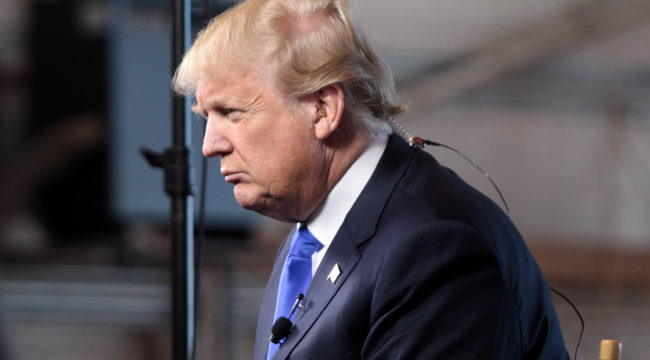Trump’s Budget: All Hat, No Cattle
Who said Donald Trump is a political amateur? Back in the day I was always miffed when the White House political staff wanted to put some “distance” between President Reagan and some of our more controversial budget cuts.
But with his first overseas trip as President, it looks like the Donald got the memo and put 6,000 miles between himself and the entire budget enchilada. That’s just as well, of course, because the Trump budget is DBA (dead before arrival) anyway.
There’s a lot to unpack here.
Trump’s budget assumes strict revenue neutrality on tax reform. It wouldn’t add to the deficit, that is — and that’s entirely commendable given the $20 trillion of debt America already has. And that’s before the $30-$35 trillion already built in over the next decade under current law.
By 2027 the national debt would be about 140% of GDP before one dime of the Trump tax reforms or other priorities are added to the equation. So the “payfor” approach to tax cuts rather than assuming that tax cuts will pay for themselves is a definite step forward.
At the same time, this disciplined approach to tax cutting is the real newsflash that Wall Street dip buyers seem to be ignoring entirely. Until now the Trump approach has implied at least short-run deficit financing for the tax cutting plan, which had Wall Street tickled pink because free fiscal lunches are what the gamblers down there mean by “stimulus.”
To be sure, this sudden lapse to pre-Reagan GOP orthodoxy on taxes is a case of all hat and no cattle. It’s short on details and just states that big rate cuts will be accompanied by a commensurate broadening of the tax base and elimination of “tax expenditures.”
But the 15% tax rate for corporations and some other businesses would cost $4.2 trillion over the next decade. Less than 10% of the Trump business tax cut can actually be financed under the revenue neutral guidelines of the Donald’s own budget.
Under the Trump budget guideline of revenue neutrality, there are probably not enough politically achievable loophole closers to fund even a 30% corporate and business tax rate. And even that would leave no room at all for personal tax cuts such as Trump’s proposed doubling of the standard deduction and the collapse of the current seven tax brackets into three brackets at 10%, 25% and 35%.
That’s all to the good relative to the nation’s headlong drift toward fiscal bankruptcy. But when fully understood, it will come as a complete shock to the Wall Street partiers who believe they are entitled to a giant Trump Tax Stimulus — even if the ultimate cost is shuffled onto unborn taxpayers.
That being said, the overwhelming share of the Trump cuts are long-overdue and well justified. But they don’t have a snowball’s chance in the hot place of being embraced on Capitol Hill by more than a small group from the House Freedom Caucus.
Even then, the proposed cuts amount to just 6% of the $52.5 trillion Federal spending baseline over the next decade. So despite all the initial arm-waving by the Dems, K-Street lobbies and their media megaphones, the Trump budget cut is not all that draconian.
The problem, of course, is the programs Trump won’t touch.
That is, most of the above massive spending baseline — about $40 trillion — consists of programs the Donald and/or the GOP mainstream promised not to touch or to actually increase. These include defense, Social Security, Medicare, net interest, veterans, border control/walls, law enforcement and other priorities.
Consequently, the big Trump budget cuts come crashing down on a tiny corner of the budget. And even there the resistance is thick on the GOP side, while the screams of unfairness from the beltway constituencies and media will be deafening.
Consider one that already has the lib-labs (liberals and labor) howling with outrage. I’m talking about the $72 billion in cuts to the social security disability insurance (SSDI) program over the next decade.
They are screaming that this betrays Trump’s campaign pledge not to touch Social Security and that it hammers people that can’t work and have no other means of support.
Nonsense!
What they aren’t telling you is that under current law the SSDI program would cost $1.8 trillion over the next decade, and the proposed savings amount to just 4% of that astounding total.
Moreover, the SSDI program has been growing like wildfire owing to drastic liberalization of eligibility during recent decades. The caseload has soared owing to alleged “bad backs” and psychiatric conditions that shouldn’t be allowed in the first place. These have caused total outlays in inflation-adjusted terms to more than triple during the last 25 years.
Needless to say, the House GOP’s fiscal year (FY) 2018 budget will water down Trump’s completely justifiable eligibility reforms to the vanishing point and the Senate GOP will deep-six them entirely.
But when you add to SSDI the cost of social security retirement and Medicare — where Trump has honored his unfortunate pledge — the built-in baseline for these three core entitlement programs is $23.5 trillion over the next decade.
Folks, the problem is that’s 45% of total Federal spending of $52.5 trillion over FY 2018-2027.
And when you add to that another $6.5 trillion for defense, where the Donald wants $500 billion more; $5.5 trillion of interest expense, which he has to pay; and $4.5 trillion for Veterans, homeland security, law enforcement and assorted other Trump priorities — he’s put a fence around $40 trillion of spending over the next decade.
Like Senator Everett Dirksen famously said, pretty soon it adds up to real money. And in the interim it amounts to 76% of total baseline outlays, and 93% of the entire $43 trillion of Federal revenues from all sources projected to be collected over the next ten years.
So where does Trump’s $3 trillion of more or less legitimate savings come from then?
The answer is from a $750 billion per year safety net which is bulging with excess and waste and which now funds more than 110 million recipients. And from about $700 billion per year allocated to the everyday functions of the Federal government. These include health research, education, farm subsidies and economic development, among thousands of others.
While all of these cuts are more than justifiable, they also constitute a giant fiscal “poison pill” from the vantage point of the legislative process. What I mean is that they will prevent any FY 2018 budget resolution at all from being adopted — meaning, in turn, no reconciliation instruction and no tax reform bill, either.
At the same time, this budgetary poison pill will so completely polarize the legislative process that the already insuperable odds against raising the debt ceiling from its current $19.8 trillion frozen level will become utterly impossible. Meanwhile, the certainty of numerous FY 2018 continuing resolution shutdown crises has been enormously increased.
Thus, consider that the built-in baseline for the major means-tested programs for the poor — Medicaid, food stamps, SSI, family support, child nutrition and the earned income tax credit — is $8.1 trillion over the next decade.
The Trump budget proposes to reduce these programs by about $1.2 trillion over that period. That’s about a 15% reduction overall, and nearly 30% for food stamps, where proposed savings total $193 billion out of baseline outlays of $675 billion.
From a purely policy perspective, that’s all to the good and fully justified, too. In fact, Team Trump found almost all of these entitlement reforms in the vaults at the Office of Management and Budget (OMB) where I left them 36 years ago. Since they had been summarily rejected by a bipartisan consensus even back then.
That is to say, there’s no way to accomplish even a fraction of these savings in today’s world — or likely the next. The mainstream GOP gave up on shrinking the welfare state long ago, and has not been remotely interested ever since Dick Cheney pronounced in 2001 that Reagan proved “deficits don’t matter.”
Actually, they very much do matter in the year 2017, but in a different sort of way than that implicit in sound economics and fiscal rectitude. I’m speaking of the practical matter that unborn generations of taxpayers are at least partially protected by a 100-year old relic — the public debt ceiling mechanism first enacted in 1917.
The Trump budget will cause the GOP coalition of factions to completely shatter, making fiscal governance impossible.
Regards,
David Stockman
for The Daily Reckoning
Trump photo: Gage Skidmore/Flickr – flickr.com



Comments: